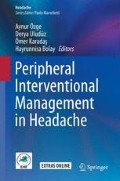Abstract
The functional anatomy of the trigeminal nerve and upper cervical nerves in transmitting head and neck pain is briefly reviewed. The chapter will focus on specific structures that interventional approaches target in headache management. The aim is to provide a general view and an understanding of the mechanisms underlying peripheral nerve interventions in clinical practice.
Access this chapter
Tax calculation will be finalised at checkout
Purchases are for personal use only
References
Bolay H, Messlinger K, Dux M, Akcali D. Anatomy of headache. In: Marteletti P, Jensen R, editors. Pathophysiology of headaches. Switzerland: Springer International Publishing; 2015. p. 1–29.
McNaughton FL, Feindel WH. Innervation of intracranial structures: a reappraisal Physiological aspects of Clinical Neurology. Oxford: Blackwell Scientific Publications; 1977. p. 279–93.. ed. Rose, F. C
Bogduk N. Anatomy and physiology of headache. Biomed Pharmacother. 1995;49(10):435–45.
Mancall EL, Brock DG, editors. Cranial meninges in Grey’s Clinical Neuroanatomy. Philadelphia: Elsevier; 2011. p. 69–83.
Kosaras B, Jakubowski M, Kainz V, Burstein R. Sensory innervation of the calvarial bones of the mouse. J Comp Neurol. 2009;515(3):331–48.
Arbab MA, Delgado T, Wiklund L, Svendgaard NA. Brain stem terminations of the trigeminal and upper spinal ganglia innervation of the cerebrovascular system: WGA-HRP transganglionic study. J Cereb Blood Flow Metab. 1988;8(1):54–63.
Lee SH, Hwang SJ, Koh KS, Song WC, Han SD. Macroscopic innervation of the dura mater covering the middle cranial fossa in humans correlated to neurovascular headache. Front Neuroanat. 2017;11:127.
Mørch CD, Hu JW, Arendt-Nielsen L, Sessle BJ. Convergence of cutaneous, musculoskeletal, dural and visceral afferents onto nociceptive neurons in the first cervical dorsal horn. Eur J Neurosci. 2007;26(1):142–54.
Bartsch T, Goadsby PJ. Increased responses in trigeminocervical nociceptive neurons to cervical input after stimulation of the dura mater. Brain. 2003;126(Pt 8):1801–13.
Piovesan EJ, Kowacs PA, Tatsui CE, Lange MC, Ribas LC, Werneck LC. Referred pain after painful stimulation of the greater occipital nerve in humans: evidence of convergence of cervical afferences on trigeminal nuclei. Cephalalgia. 2001;21(2):107–9.
Bolay H, Reuter U, Dunn AK, Huang Z, Boas DA, Moskowitz MA. Intrinsic brain activity triggers trigeminal meningeal afferents in a migraine model. Nat Med. 2002;8(2):136–42.
Simon B, Blake J. Mechanism of action of non-invasive cervical vagus nerve stimulation for the treatment of primary headaches. Am J Manag Care. 2017;23(17 Suppl):S312–6.
Guo CC, Sturm VE, Zhou J, Gennatas ED, Trujillo AJ, Hua AY, Crawford R, Stables L, Kramer JH, Rankin K, Levenson RW, Rosen HJ, Miller BL, Seeley WW. Dominant hemisphere lateralization of cortical parasympathetic control as revealed by frontotemporal dementia. Proc Natl Acad Sci USA. 2016;113(17):E2430–9.
Gebhart GF. Descending modulation of pain. Neurosci Biobehav Rev. 2004;27:729–37.
Abdallah K, Artola A, Monconduit L, Dallel R, Luccarini P. Bilateral descending hypothalamic projections to the spinal trigeminal nucleus caudalis in rats. PLoS One. 2013;8(8):e73022.
Millan MJ, Gramsch C, Przewłocki R, Höllt HA. Lesions of the hypothalamic arcuate nucleus produce a temporary hyperalgesia and attenuate stress-evoked analgesia. Life Sci. 1980;27(16):1513–23.
Author information
Authors and Affiliations
Corresponding author
Editor information
Editors and Affiliations
Rights and permissions
Copyright information
© 2019 Springer Nature Switzerland AG
About this chapter
Cite this chapter
Bolay, H., Karadas, O. (2019). Headache Anatomy and Mechanisms of Peripheral Nerve Interventions. In: Özge, A., Uludüz, D., Karadaş, Ö., Bolay, H. (eds) Peripheral Interventional Management in Headache. Headache. Springer, Cham. https://doi.org/10.1007/978-3-030-10853-3_2
Download citation
DOI: https://doi.org/10.1007/978-3-030-10853-3_2
Publisher Name: Springer, Cham
Print ISBN: 978-3-030-10852-6
Online ISBN: 978-3-030-10853-3
eBook Packages: MedicineMedicine (R0)

